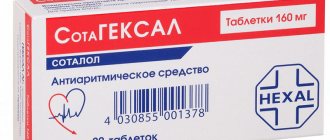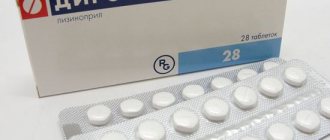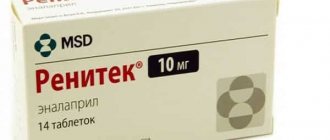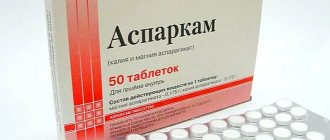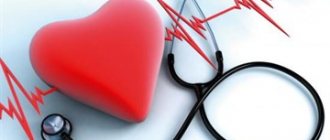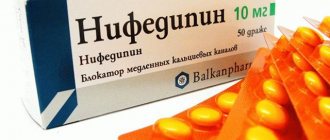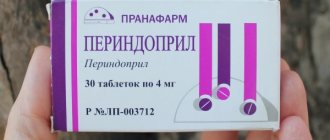1348
With age, the load on the heart increases; due to frequent stress, interruptions in blood circulation occur, veins and arteries narrow. In such cases, doctors recommend the use of drugs that purify the blood and remove platelet deposits on the walls of blood vessels. Such drugs include Prazosin. It blocks alpha adrenergic receptors and dilates blood vessels.
Directions for use and dosage
The drug is taken orally, the initial single dosage is equal to 0.5 mg, taken 2-3 times a day. Subsequently, the dose of the drug is gradually increased to the required optimal value to ensure a hypotensive effect. A persistent decrease in blood pressure is observed after 4-6 weeks; the maintenance dosage is selected individually within the range of 3-20 mg per day, divided into several doses.
As indicated in the instructions for Prazosin, during monotherapy, tolerance to the drug may develop: early - on the third to fifth day of administration, late - after several months of treatment; in such cases, it is recommended to prescribe diuretics or increase the single dose (by 1 mg or more). If the effectiveness of the drug is insufficient or slowly manifested, diuretic or antihypertensive drugs may also be prescribed at the same time. The dosage of Prazosin is reduced to 1-2 mg, taken three times a day, then it is gradually increased to the optimal one.
For the treatment of CHF, Prazosin is prescribed according to the usual regimen: an initial dose of no more than 0.5 mg per day, then a gradual increase to 3-20 mg per day, used 2-3 times. When using the tablets for the first time, after taking them the patient must remain in bed for more than 2 hours due to the risk of postural hypotension - a sharp decrease in blood pressure, up to a short-term loss of consciousness.
When treating Raynaud's syndrome, the medicine is usually taken at 0.5 mg at the beginning of the course, and then the dosage is increased to 1-2 mg twice a day, the maximum daily dose is 6 mg. For the symptomatic treatment of dysuric disorders due to prostatic hypertrophy, Prazosin is prescribed twice a day: 0.5 mg during the first week, 1 mg during the second, 2 mg from 3 to 6 weeks.
To eliminate spasms of peripheral arteries caused by poisoning with ergot alkaloids, the drug is prescribed 1 mg three times a day.
Pharmacodynamics and pharmacokinetics
As a result of the attachment of "prazosin" to the alpha-1 adrenergic receptors, adrenaline itself can no longer attach to them, which leads to their blocking. This process leads to the following effects:
- Blood pressure decreases;
- The vessels dilate, their capacity decreases, the pressure in the right atrium and pulmonary veins decreases significantly;
- Reduces myocardial oxygen demand;
- Slightly retains fluid in the body without harming the kidneys;
- Improves lipid metabolism, increases the amount of high-density lipoproteins and, accordingly, reduces cholesterol and low- and very low-density lipoproteins;
- It has no effect on the metabolism of glucose and uric acid, so there are no contraindications for use by people with diabetes and gout.
- Increases body weight due to water retention;
- It does not affect renal filtration, due to the dilation of blood vessels, including the renal arteries and veins, and reduces their resistance.
Thus, the main effects of the drug, which determine its indications:
- Reduces blood pressure;
- Dilates blood vessels;
- Improves diuresis.
After administration, the medicine is quickly absorbed in the digestive tract and is 97% bound to blood proteins in the blood. Bioavailability may vary with food intake. Metabolism takes place in the liver, resulting in the formation of 4 metabolites that retain their therapeutic activity. Excreted in bile and urine. In case of insufficient renal function, plasma concentrations may increase, leading to side effects.
Side effects
Treatment with Prazosin, according to the instructions, may be accompanied by:
- Headache, weakness, anxiety, insomnia, fatigue, dizziness, depression, hallucinations, paresthesia, emotional disorders;
- Tachycardia, excessive decrease in blood pressure, anginal pain, shortness of breath, palpitations, peripheral edema (with prolonged use), very rarely - orthostatic collapse (especially after taking the first dose);
- Dry mouth, constipation, vomiting, diarrhea, nausea;
- Visual impairment, tinnitus, hyperemia of the conjunctiva and cornea, darkening of the eyes.
Also, taking Prazosin can provoke the appearance of: hyperthermia, frequent urination, nosebleeds, alopecia, nasal congestion, hyperhidrosis, decreased potency, arthralgia, priapism, skin rash, itching.
Other names and classification
The medication in question has several different names.
The drug has a vasodilating effect and reduces the load on the heart muscle.
Russian name
In domestic sources, the drug is called Prazosin.
Latin name
In Latin the medicine is called Prazosinum.
Trade names
This pharmaceutical product is marketed under various trade names:
- Polpressin;
- Pratsiol;
- Deprazoline;
- Adverzuten;
- Minipress;
- Vasoflex;
- Hypovas;
- Declitene, etc.
This drug may be marketed under a commercial name such as Minipress.
These names are synonyms.
CAS code
The Chemical Abstract Service entered this medicine into the registration database under the number 19216-56-9.
special instructions
Therapy with the drug should be carried out with regular monitoring of blood pressure and heart rate with the patient standing and lying down.
The risk of an excessive decrease in blood pressure increases in patients taking diuretics, beta-blockers, sympatholytics, Nifedipine.
When Prazosin is used with Propranolol, severe arterial hypotension may develop, and combined use with Indomethacin may reduce the effect of the drug.
Combined use with Digoxin contributes to a significant increase in the level of the latter in the blood.
Indications and contraindications
"Prazosin", instructions for use - indications:
- Hypertension, essential or secondary, of any degree, as monotherapy or in combination with other antihypertensive drugs;
- Initial stages of chronic heart failure, as a combination therapy for congestive failure;
- Benign prostatic hyperplasia with impaired diuresis.
A prescription for the drug is issued by a cardiologist after determining the need and safety of the drug.
Classification of hypertension by degree
The list of contraindications for use includes:
- Hypersensitivity to any substances in the composition, especially in the case of a history of anaphylactic reactions;
- Heart failure in case of constrictive pericarditis of any etiology;
- Cardiac tamponade;
- Low pressure in the left ventricle, which may be caused by dysfunction of the valves, failure of the heart muscle, myocardial infarction and other reasons;
- Childbearing and lactation period. Before prescribing, you must ensure that you are not pregnant.
- Use with caution in people with low blood sodium.
Drug interactions
- It is not recommended to take doxazosin concomitantly with other α1-adrenergic receptor blockers.
- When used simultaneously with antihypertensive drugs, mutual enhancement of effects is possible.
- With the simultaneous use of drugs that affect the rate of metabolism in the liver, the metabolism of doxazosin may be slowed down or accelerated.
- When used simultaneously with calcium channel blockers, there is some risk of developing severe arterial hypotension.
- When used simultaneously with nitrates, general anesthesia, tricyclic antidepressants, ethanol, the hypotensive effect may be enhanced.
- When used simultaneously with PDE-5 inhibitors (sildenafil, tadalafil, tardenafil, vardenafil), symptomatic arterial hypotension may develop in some patients.
- Estrogens and sympathomimetic agents may reduce the hypotensive effects of doxazosin. By eliminating the alpha-adrenergic stimulating effects of epinephrine (adrenaline), doxazosin can lead to tachycardia and hypotension.
We have selected some people's reviews about the drug Doxazosin:
- Zakhar. I’ve been taking doxazosin since 1998. It seems to me that thanks to it I haven’t needed surgery yet. Sometimes, when I don’t have it, I take sonisin or omnic, but doxazosin helps lower my blood pressure, so I mostly use it.
Doxazosin has a large number of positive reviews. Patients note a pronounced hypotensive effect, a gradual decrease in pressure, and a mild effect. Elderly men suffering from hypertension and prostate hyperplasia respond especially well. Such patients report a significant decrease in burning sensation when urinating, and a decrease in the number of nights getting up to go to the toilet.
In any case, treatment with this drug requires a careful approach. Only a specialist should prescribe the dose and therapeutic regimen, after thorough diagnostic studies.
In addition, periodic examinations and visits to the doctor are required during treatment.
Almost any medical drug has its analogues. Doxazosin was no exception. Instead, you can use several other products that have a similar type of action. In this case, minor differences can be observed only in the list of indications for use and the price category of medications.
So, what are the analogues of the drug we are considering? "Doxazosin" can be replaced with the following drugs:
Before using analogues, consult your doctor.
Analogues and prices
It is easier to replace Doxazosin with similar drugs (synonyms), which may have a different name, but the active substance will be the same. You can, however, look for other types of alpha1-blockers, or even change the group of drugs to 5-alpha reductase inhibitors, which are also effective for BPH. The most popular, according to current reviews, are the following medications:
- terazosin - Setegis, Kornam, Haytrin, Terazosin-Teva;
- prazosin – Prazosin, Polpressin;
- tamsulosin - Omnic, Proflosin, Sonizin, Omsulosin, Hyperprost, Tamsulon;
- alfuzosin – Alfuprost, Dalfaz, Alfuzosin;
- finasteride - Penester, Proscar, Finast, Alfinal, Prosteride;
- dutasteride – Avodart, Dutasteride Bacter.
There are also medications that are used in the treatment of prostate adenoma, but act due to natural ingredients: Tykveol, Tadimax, Prostavern Urtika, Permixon, Prostaplant, Vitaprost and others.
The current cost of a number of listed drugs (which can be purchased at a pharmacy only with a prescription) is presented in the following table:
Composition and dosage forms
The drug is available only in tablet form. The tablets are round in shape and white in color. There is a notch for breaking in the center of one of the sides. The active component in them is represented by prazosin hydrochloride in an amount of 0.5 or 1 mg. Excipients:
- starch;
- lactose monohydrate;
- magnesium stearate;
- anhydrous form of silicon dioxide.
Tablets 30 pcs. packaged in plastic bottles, which are placed in boxes along with the package insert. Packages of 50 and 100 tablets are available.
The tablets are round in shape and white in color.
Prazosin
Prazosin: instructions for use and reviews
Latin name: Prazosin
ATX code: C02CA01
Active ingredient: Prazosin (Prazosin)
Manufacturer: Norton Healthcare (UK)
Update of description and photo: 10/02/2019
Prazosin is a selective blocker of postsynaptic alpha1-adrenergic receptors, a drug with antihypertensive and vasodilating effects.
Release form and composition
Available in the form of tablets (30 pieces in polypropylene bottles, 1 bottle in a cardboard pack).
The active substance is prazosin, 0.5 or 1 mg in 1 tablet.
Pharmacodynamics and pharmacokinetics
According to the instructions, Prazosin has the following effects on the body:
- blocking postsynaptic α1-adrenergic receptors;
- reducing the vasoconstrictor effect of catecholamines;
- decrease in total peripheral vascular resistance and decrease in blood pressure;
- expansion of peripheral veins;
- reduction of afterload on the heart;
- decreased pressure in the pulmonary circulation;
- improvement of intracardiac and systemic hemodynamics in chronic heart failure;
- decreased myocardial oxygen demand and increased stroke volume during exercise;
- decreased renal vascular resistance;
- reducing pressure and resistance in the urethra and reducing the severity of symptoms of urinary tract dysfunction.
Taking the drug may be accompanied by the development of moderate reflex tachycardia. With long-term use, a decrease in the concentration of atherogenic lipids in the blood is observed.
After taking a single dose, the maximum hypotensive effect develops within 1–4 hours. The duration of action of the drug is up to 10 hours. During treatment, early (after 3–5 days) or late (by 12 months) tolerance may develop, so the doctor may decide to increase the dose.
The drug is quickly absorbed from the gastrointestinal tract (food intake does not affect absorption). The maximum concentration in the blood is achieved within 1–3 hours. The bioavailability of Prazosin ranges from 50 to 85%, binding to plasma proteins exceeds 95%. The drug is metabolized in the liver.
The half-life of Prazosin is from 2 to 4 hours. The drug is excreted primarily in bile. In patients with chronic renal failure and elderly patients, the half-life is prolonged.
Indications for use
- Arterial hypertension;
- Congestive heart failure.
Contraindications
- Heart disease with reduced filling pressure of the left ventricle;
- Constrictive pericarditis;
- Hypotension;
- Cardiac tamponade;
- Children under 12 years of age;
- Pregnancy and lactation period;
- Hypersensitivity to the drug.
Instructions for use of Prazosin: method and dosage
The tablets should be taken orally. Eating does not affect the effectiveness of the drug.
At the beginning of treatment of arterial hypertension, 0.5 mg is prescribed at bedtime. The dose is gradually increased, first to 1 mg 3-4 times a day, and then until a stable reduction in blood pressure is achieved (usually this takes from 4 to 8 weeks). The optimal daily dose for each patient can vary between 3-20 mg, most often 6-15 mg. The total daily dose is divided into 3-4 doses.
When prescribing Prazosin as a single drug, it is necessary to take into account the possibility of developing tolerance. It is possible at the beginning of treatment (on days 3-5) or after a few months. This phenomenon requires an increase in the dose of prazosin or additional administration of diuretics.
If the hypotensive effect develops slowly or is insufficient, other antihypertensive drugs or diuretics are additionally prescribed. In this case, the dose of Prazosin is reduced to 1-2 mg 3 times a day, a second drug is added, and then the dose is gradually increased again, selecting the most appropriate treatment regimen.
The duration of use of the drug is not limited.
For congestive heart failure, 3-20 mg/day is prescribed in 3-4 doses.
The maximum permissible daily dose for adults is 20 mg.
Overdose
Taking very high doses of the drug can cause a significant decrease in blood pressure. In such cases, it is recommended to take a horizontal position and raise your legs.
Side effects
- From the central and peripheral nervous system: headache, weakness, vertigo, sleep disorders, emotional disorders, hallucinations, anxiety, perception disorders, depression, fatigue, paresthesia;
- From the cardiovascular system: anginal pain, shortness of breath, tachycardia, palpitations, arterial hypotension (especially orthostatic); with long-term use – swelling of the lower extremities; rarely – orthostatic collapse (usually after taking the first dose);
- From the urinary system: frequent urination;
- From the digestive system: diarrhea or constipation, nausea, vomiting, dry mouth;
- From the senses: blurred vision, darkening of the eyes, hyperemia of the cornea and conjunctiva, tinnitus;
- Allergic reactions: skin rash, itching;
- Other: hyperthermia, nasal congestion, hyperhidrosis, arthralgia, nosebleeds, the appearance of antinuclear factors, alopecia, decreased potency, priapism.
special instructions
During treatment, it is necessary to constantly monitor heart rate and blood pressure, both in the supine and standing positions.
Patients receiving beta-blockers, sympatholytics, and diuretics are more likely to experience hypotension.
Use during pregnancy and lactation
It is prohibited to use the drug during this period.
Use in childhood
It is prohibited to use the drug in the treatment of children under 12 years of age.
Drug interactions
Prazosin is incompatible with nifedipine. Its effect is enhanced by sympatholytics, diuretics, and beta-blockers.
With the simultaneous use of beta-blockers, angiotensin-converting enzyme inhibitors, calcium channel blockers, the risk of severe arterial hypotension increases, especially after taking the first dose of prazosin.
The vasodilating effects of calcium channel blockers and alpha-blockers may be synergistic or additive. With simultaneous use of prazosin with verapamil, the development of severe arterial hypotension is partly due to their pharmacokinetic interaction: the maximum concentration increases and the total concentration of prazosin increases.
Indomethacin may reduce the effect of prazosin.
Prazosin promotes a rapid and significant increase in plasma digoxin levels and may alter the antihypertensive effect of clonidine.
Patients receiving propranolol are at risk of developing severe hypertension after the first dose of prazosin.
Analogs
Analogs of Prazosin are: Pratsiol, Adverzuten, Eurex, Minipress.
Terms and conditions of storage
Store at temperatures up to 25 ºС in a place protected from light, dry and out of reach of children.
Shelf life – 3 years.
Conditions for dispensing from pharmacies
Dispensed by prescription.
Reviews about Prazosin
Reviews about Prazosin are positive: it is successfully used not only for high blood pressure, but also for prostatic hyperplasia and pheochromocytoma.
Price for Prazosin in pharmacies
The drug is not available in most pharmacies, so the price of Prazosin is unknown.
Education: Rostov State Medical University, specialty “General Medicine”.
Information about the drug is generalized, provided for informational purposes and does not replace official instructions. Self-medication is dangerous to health!
The first vibrator was invented in the 19th century. It was powered by a steam engine and was intended to treat female hysteria.
Four pieces of dark chocolate contain about two hundred calories. So if you don’t want to gain weight, it’s better not to eat more than two slices a day.
According to many scientists, vitamin complexes are practically useless for humans.
There are very interesting medical syndromes, for example, compulsive swallowing of objects. One patient suffering from this mania had 2,500 foreign objects in her stomach.
Each person has not only unique fingerprints, but also tongue prints.
74-year-old Australian resident James Harrison has donated blood about 1,000 times. He has a rare blood type whose antibodies help newborns with severe anemia survive. Thus, the Australian saved about two million children.
According to statistics, on Mondays the risk of back injuries increases by 25%, and the risk of a heart attack by 33%. Be careful.
In order to say even the shortest and simplest words, we use 72 muscles.
Scientists from Oxford University conducted a series of studies in which they came to the conclusion that vegetarianism can be harmful to the human brain, as it leads to a decrease in its mass. Therefore, scientists recommend not completely excluding fish and meat from your diet.
The human stomach copes well with foreign objects without medical intervention. It is known that gastric juice can even dissolve coins.
More than $500 million a year is spent on allergy medications in the United States alone. Do you still believe that a way to finally defeat allergies will be found?
Millions of bacteria are born, live and die in our intestines. They can only be seen under high magnification, but if they were put together, they would fit in a regular coffee cup.
The rarest disease is Kuru disease. Only members of the For tribe in New Guinea suffer from it. The patient dies of laughter. The disease is believed to be caused by eating human brains.
Human blood “runs” through the vessels under enormous pressure and, if their integrity is violated, it can shoot at a distance of up to 10 meters.
Tooth decay is the most common infectious disease in the world, which even the flu cannot compete with.
Deep sleep for the body is not just a time of rest, it is a special state when the body is engaged in “technical inspection”, “cleaning”, eliminating minor problems.

